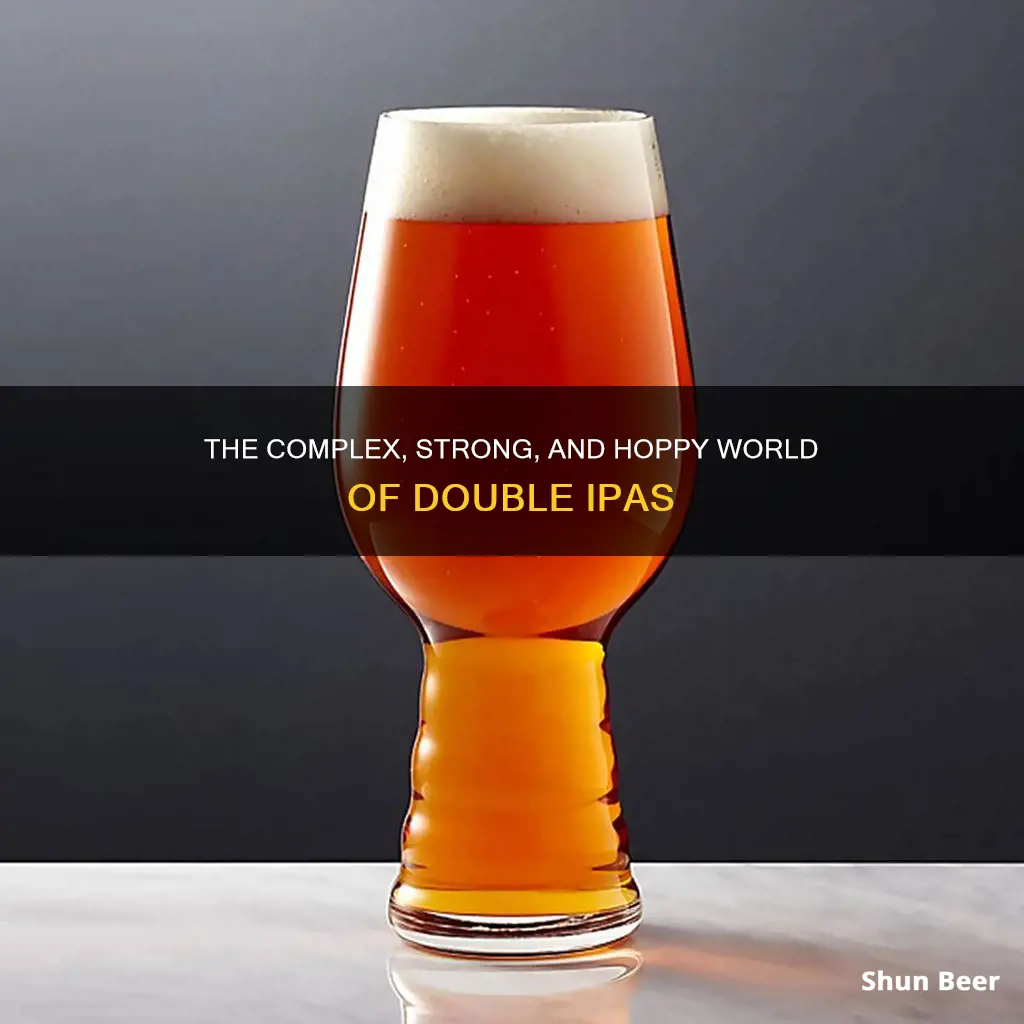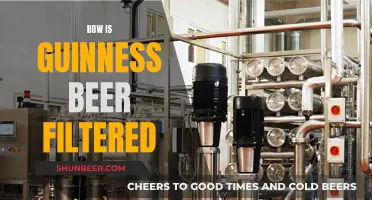
Double IPAs, also known as Imperial IPAs, are a uniquely American style of beer that takes the India Pale Ale (IPA) and amps up the hops, malt and alcohol content. With double or even triple the hops of a regular IPA, double IPAs are known for their intensely hoppy, bitter flavour and strong aroma. They also have a higher alcohol content, typically ranging from 7% to 10% ABV, and are often dry-hopped to create a bold, smooth brew. The style is said to have originated in California in the 1990s, and has since become a popular craft beer choice in the US and beyond.
Characteristics of a Double IPA Beer
| Characteristics | Values |
|---|---|
| Alcohol Content | 7-10% ABV |
| Malt | Extra malt provides a more distinct toasted or caramel malt flavor |
| Hops | Double or triple the hops of a regular IPA |
| Bitterness | 65-90 International Bittering Units |
| Color | Honey amber |
| Flavor | Hoppy, bitter, malty |
| Aroma | Hop aromatics |
What You'll Learn

History of double IPAs
The history of double IPAs, or Imperial IPAs, dates back to the 1990s when the style was first brewed in the United States. However, to understand the origins of double IPAs, it is essential to go back to the history of India Pale Ales (IPAs).
The widely accepted story of IPAs is that they were brewed in England specifically to survive the long journey to the British colonies in India during the 1700s. The antibacterial properties of hops and the higher alcohol content helped preserve the beer during its voyage to India. However, this story is not entirely accurate, as porters and other dark beers were also exported and enjoyed in India during that time.
The popularity of IPAs grew in India due to its hot climate. The refreshing and hoppy nature of IPAs was more appealing to drinkers in India than the thick and malty brown ales. As a result, British brewers capitalised on this popularity by marketing the pale ale as "India Pale Ale" back home in England.
By the mid-19th century, the IPA style was in high demand in England and abroad. However, the IPAs of that time would be almost unrecognisable to those who drink modern craft IPAs. The craft beer revolution in the United States during the late 20th century led to experimentation with the traditional British ale styles, including IPAs.
The creation of the double IPA is attributed to a brewer in Southern California who accidentally added too much malt to the mash. Instead of discarding the batch, he added more hops to balance the flavours, resulting in a boozy and hoppy beer. Vinnie Cilurzo of Blind Pig Brewery in Temecula, California, is also credited with creating the first double IPA, the Inaugural Ale, in 1994.
Double IPAs, or Imperial IPAs, are characterised by their higher alcohol content, typically ranging from 7% to 10% ABV, and a more intense hoppy flavour and aroma compared to regular IPAs. The term "double" refers to the increased amount of ingredients used, especially hops, resulting in a beer that is both higher in alcohol content and richer in hop character.
Guinness Beer: A Source of Vitamins?
You may want to see also

Alcohol content
Double IPAs, or Imperial IPAs, are known for their high alcohol content. While a typical IPA stays at or below 7% ABV, a double IPA will have an ABV range of 7-10%. Some sources state that once an IPA reaches the 7-plus percent ABV range, it's considered a Double IPA.
The higher alcohol content in a Double IPA is achieved by adding more malt. The extra malt provides more sugar for the yeast to convert into alcohol, resulting in a stronger brew. However, brewers must be careful not to add too much malt, as this can result in a beer that is overly sweet and unbalanced.
The alcohol content of a Double IPA is not always double that of a standard IPA, but it is typically higher. The increase in alcohol content is usually around 1.33-1.66 times that of a regular IPA. This means that a Double IPA offers more flavour and a stronger effect without being overwhelming.
While the exact recipe for a Double IPA may vary depending on the brewer, the goal is always to create a beer with a higher alcohol content than a standard IPA while maintaining a balanced and assertive flavour profile.
Guinness Nitro Beers: Nitrogen-Infused Smoothness or Marketing Hype?
You may want to see also

Hop content
Double IPAs, also known as DIPAs or Imperial IPAs, are characterised by their high hop flavour and aroma. The hop aroma derives from American or New World hops and consists of floral, citrus, stone fruit, pine/resin, tropical fruit, berry, and melon notes. The hop flavour is similarly varied, with American or New World hops providing a range of flavours. The hop bitterness can be high, with bitterness levels ranging from sixty-five to ninety IBUs.
The hop-centric nature of double IPAs is achieved by adding more hops to the brewing process. The addition of hops throughout the brewing process can change the bitterness and flavour profile of the beer. Dry hopping is very common with this style and is encouraged to extract more hop aroma and flavour.
The style is also defined by its higher alcohol content, usually ranging from 7.5% to 10% ABV, compared to traditional IPAs which typically fall between 5% to 7.5% ABV. The higher alcohol content is achieved by adding more malt, which provides more fermentable sugars. The malt backbone is essential to carrying the high bitterness level of the beer, and a counterbalance of malty sweetness and hoppy bitterness must work in harmony.
Guinness Beer vs. World Records: What's the Difference?
You may want to see also

Malt content
Malt is a key ingredient in any beer, and the type and amount of malt used will have a significant impact on the final product. This is no different when it comes to double IPAs.
Double IPAs, or Imperial IPAs, originated in the USA in the 1990s and are characterised by their strong, hoppy flavour and high alcohol content. They typically have an alcohol content of 7-10% ABV, which is achieved by adding more fermentable sugars to the mash, and thus, more malt. The extra malt also helps to balance out the increased bitterness that comes from the higher number of hops used in double IPAs.
When it comes to the malt bill for a double IPA, the majority of the grist—at least 80%—is typically made up of a base malt. The specific type of base malt used is usually down to the brewer's preference, but due to the prominent influence of hops in this style, a malt with a light flavour is more common. Examples include Golden Promise, Low Colour Maris Otter, Extra Pale Ale, or Finest Lager malts.
In addition to the base malt, crystal malts are also used in double IPAs. Crystal malts contain unfermentable sugars, which can add sweetness to the beer without increasing the alcohol content. As such, it is recommended that crystal malts make up no more than 5% of the total grist in a double IPA.
To enhance the haziness of a double IPA's appearance, brewers may also incorporate extra special malts and grains, such as Dextrin malt (also known as Carapils), Wheat Malt, Flaked Barley, Flaked Wheat, or Flaked Oats. These ingredients can be used sparingly, typically in amounts of 5% or less, to add body, mouthfeel, and foam stability to the beer.
Overall, the malt content of a double IPA is crucial in achieving the desired alcohol content, flavour profile, and appearance. Brewers must carefully select and proportion their malts to create a well-balanced beer that showcases the unique characteristics of this style.
Guinness Beer Widget: What's Its Purpose?
You may want to see also

Colour
Double IPAs, also known as Imperial IPAs, are a stronger, hoppier variant of the classic IPA. They typically have an alcohol content of over 7.5% ABV. The style is claimed to have originated with Vinnie Cilurzo, currently the owner of Russian River Brewing Company, in 1994 at the now-defunct Blind Pig Brewery in Temecula, California.
Double IPAs are characterised by their intense hoppiness, strong aroma, and higher alcohol content when compared to a standard IPA. They are often described as having a rich golden or amber colour, with a smooth, medium body. While the specific hues and tones may vary, the colour of a Double IPA will generally fall within the golden-amber spectrum.
The colour of a Double IPA is influenced by the malts used during the brewing process. While IPAs are typically brewed with pale malts, Double IPAs may use a combination of pale, caramel, and crystal malts to achieve their distinct colour and flavour profile. The addition of specialty malts, such as crystal malt, can contribute to a darker, amber hue in the final beer.
The Beer Judge Certification Program (BJCP) provides guidelines for the Double IPA style, describing it as a "fairly pale beer ranging from straw gold to a more bronzy orange". The BJCP further notes that the clarity of the beer will depend on whether, and to what extent, dry hopping was performed during brewing. Many Double IPAs are very clear, while others that have undergone dry hopping and minimal or no filtration may exhibit a hazy appearance.
The colour of a Double IPA can also be influenced by the type of hops used. While the hue may vary, the intense hopping rates of a Double IPA will generally result in a beer that is darker in colour compared to a standard IPA. The use of certain hops, such as Cascade, Centennial, Chinook, and Citra, can contribute to a more amber hue due to the higher presence of alpha acids and other compounds that affect the colour and clarity of the beer.
Guinness Beer and Sulfites: What's the Connection?
You may want to see also
Frequently asked questions
Double IPA, also known as Imperial IPA, is a style of beer that takes the India Pale Ale (IPA) and amps up the hops, malt, and alcohol content.
A regular IPA typically has an ABV range of 5-7%, while a double IPA will have an ABV range of 7-10%, or even higher, depending on the source. Double IPAs also tend to have a more robust and varied flavor profile, often taking twice as long to brew.
The double IPA was first created in California in 1994 or 1995, with its origins attributed to a brewer in Temescal, CA. The style emerged from experimentation with the West Coast IPA, which itself was a variation on the original British IPA style.
To make a double IPA, brewers increase the amount of hops and malt used in the brewing process. This results in a beer with higher alcohol content and a more intense bitterness and aroma. The extra malt provides a more distinct toasted or caramel malt flavor, and the additional yeast converts more sugar into alcohol, creating a stronger brew.







